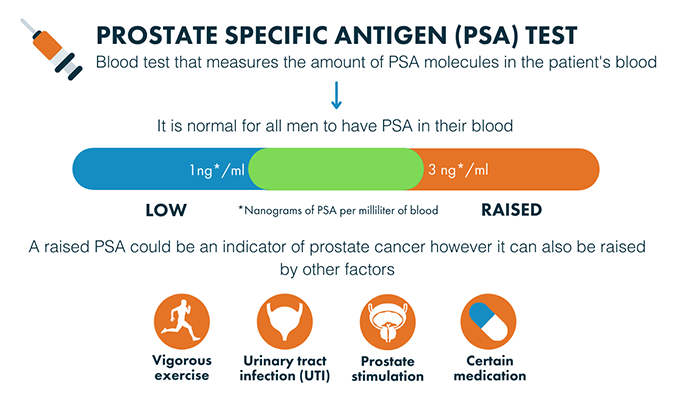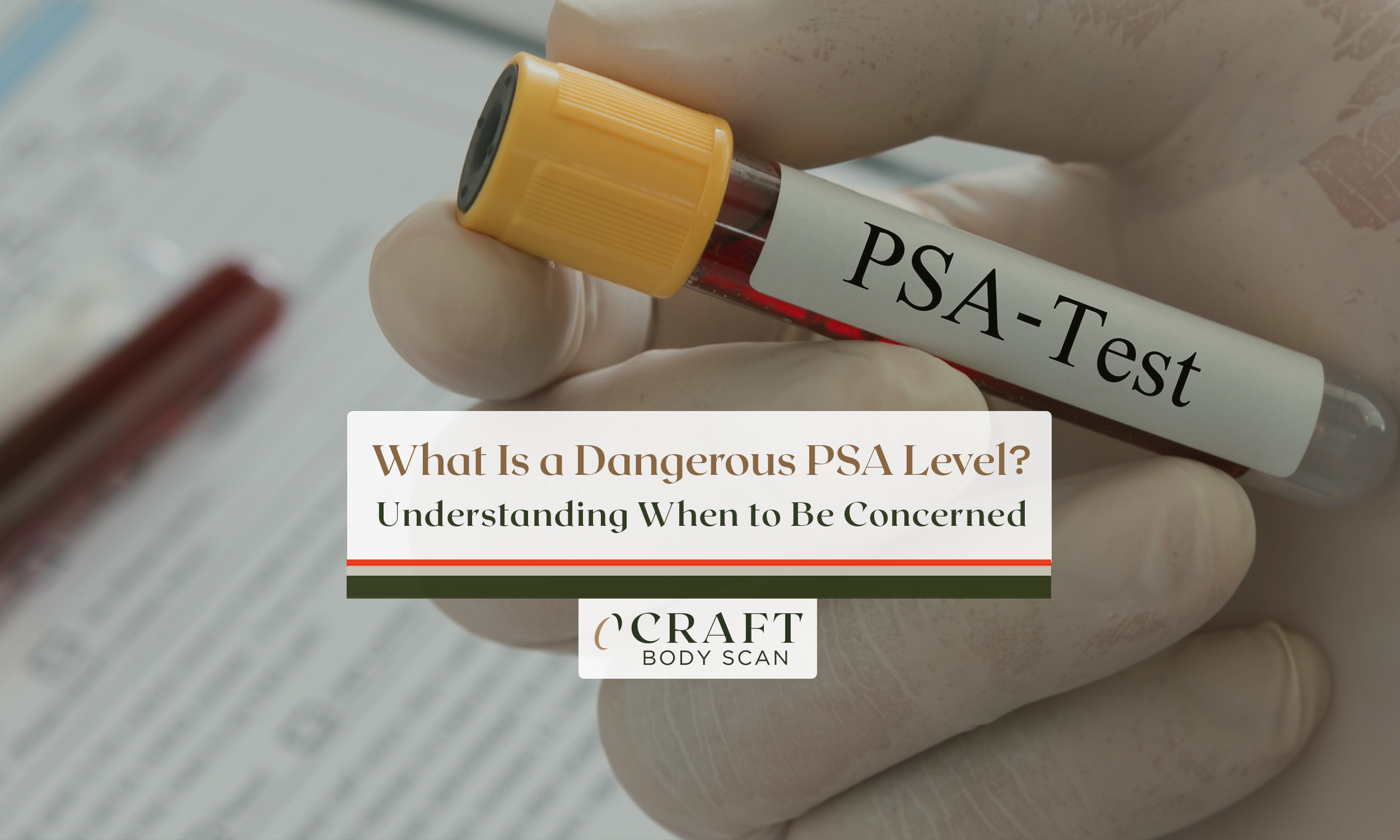If you’re staring at your PSA test results feeling confused and worried, you’re not alone. As healthcare specialists who have guided thousands of men through elevated PSA readings, we see that same look of concern when patients receive numbers that seem high. Your mind might be racing to worst-case scenarios, and you’re probably asking yourself: Is my PSA level actually dangerous?
Here’s what we want you to know: a dangerous PSA level is generally considered to be above 10 ng/mL, as this indicates a 50% or higher probability of prostate cancer. However, PSA levels between 4-10 ng/mL also require careful evaluation and may signal significant risk depending on your age, symptoms, and how quickly the levels are changing. But understanding what makes a PSA level truly dangerous involves much more than just looking at a single number.
After years of interpreting PSA results and helping men navigate prostate health concerns, we’ve learned something important: context matters more than absolute numbers. When you understand what constitutes a dangerous PSA level and why, you can take appropriate action without letting unnecessary panic take over.
NOTE: For more information on the prostate and its function inside your body, click here.
Understanding PSA Levels and Cancer Risk
Your PSA (Prostate-Specific Antigen) reading represents much more than just a number on a lab report—it’s a window into your prostate’s health status. While PSA isn’t exclusively produced by cancer cells, significantly elevated levels often indicate serious problems that deserve immediate attention.
The relationship between PSA levels and cancer risk isn’t as straightforward as you might think. A PSA of 8 ng/mL doesn’t represent twice the cancer risk of 4 ng/mL. Instead, cancer probability increases more dramatically as PSA levels rise, which is why extremely high readings are particularly concerning.
What makes a PSA level dangerous depends on several important factors that are specific to you. Your age plays a crucial role—a PSA of 6 ng/mL might be acceptable for a 75-year-old but concerning for a 50-year-old. Often, the rate at which your PSA is increasing matters more than the absolute level, since rapidly rising PSA can indicate aggressive cancer even when levels remain relatively moderate.
The concern with elevated PSA lies in what it might represent. While benign conditions like an enlarged prostate (BPH) or infections can raise PSA levels, readings above certain thresholds significantly increase the likelihood of cancer. This is why healthcare providers treat high PSA levels with such seriousness.
Understanding your specific risk requires looking beyond just the PSA number itself. Your family history, race, any symptoms you’re experiencing, and findings from physical examinations all influence how concerning a particular PSA level might be for your individual situation.
PSA Levels That Require Immediate Attention

Certain PSA levels demand urgent evaluation because they indicate a high probability of serious prostate problems. These thresholds help healthcare providers prioritize cases and determine the most appropriate next steps for your care.
PSA Above 10 ng/mL: This represents what we consider the clearest danger zone. Men with PSA levels above 10 ng/mL have approximately a 50% chance of having prostate cancer. At this level, immediate consultation with a urologist and further testing become essential. The higher your PSA climbs above 10, the greater the cancer risk becomes.
PSA Above 20 ng/mL: PSA levels in this range indicate extremely high cancer probability, often exceeding 75%. These levels frequently suggest not just the presence of cancer, but potentially advanced or aggressive disease. Men with PSA readings this high need expedited evaluation and staging studies.
PSA Above 50 ng/mL: Levels this elevated almost certainly indicate prostate cancer, with many cases involving advanced disease that may have spread beyond the prostate. Immediate comprehensive evaluation becomes critical for staging and treatment planning.
PSA Above 100 ng/mL: These extremely high levels typically indicate advanced prostate cancer with a high likelihood of spread to other parts of the body. Emergency consultation with a urologist and comprehensive staging studies are necessary to determine the extent of disease and appropriate treatment approaches.
However, context remains crucial even with these high levels. Acute prostatitis (a prostate infection) can temporarily drive PSA levels to 50 ng/mL or higher. This is why healthcare providers often treat suspected infections before repeating PSA tests, especially when symptoms suggest inflammation rather than cancer.
The Gray Zone: Borderline Dangerous PSA Levels
PSA levels between 4-10 ng/mL occupy what medical professionals call the “gray zone”—elevated enough to cause concern but not high enough to clearly indicate cancer. These borderline levels require careful evaluation and individual assessment based on your unique situation.
PSA 4-6 ng/mL: This range carries approximately 15-25% cancer risk, making it moderately concerning but not immediately dangerous for most men. Your age becomes crucial here—this level might be completely normal for a 70-year-old but concerning for a 45-year-old. Additional tests like free PSA percentage help refine risk assessment.
PSA 6-8 ng/mL: Cancer risk increases to 25-35% in this range, making further evaluation important. Many urologists recommend prostate biopsy at these levels, especially in younger men or those with concerning symptoms. The decision often depends on other risk factors and your personal preferences about testing.
PSA 8-10 ng/mL: This represents higher-risk territory with cancer probability reaching 35-45%. Most specialists recommend tissue sampling at these levels to rule out significant cancer. The urgency increases if your PSA has risen rapidly to reach this range.
What makes these borderline levels particularly challenging is the need to balance cancer detection against overdiagnosis. Some men in this range have slow-growing cancers that may never cause problems, while others harbor aggressive disease requiring prompt treatment.
Advanced PSA tests help refine risk assessment in the gray zone. Free PSA percentage, PSA density, and specialized tests like 4Kscore or Prostate Health Index provide additional information to guide decision-making without immediately jumping to invasive procedures.
How Rapidly Rising PSA Levels Signal Danger

PSA velocity—the rate at which PSA levels increase over time—often provides more valuable information than absolute PSA levels alone. Rapid PSA rises can indicate dangerous situations even when absolute levels remain relatively moderate.
PSA Doubling Time Under 3 Years: When PSA levels double in less than three years, this rapid rise suggests potentially aggressive prostate cancer, even if absolute PSA levels remain below traditional danger thresholds. A PSA rising from 2 to 4 ng/mL in 18 months is actually more concerning than a stable PSA of 6 ng/mL.
PSA Increase Greater Than 0.75 ng/mL Per Year: Annual PSA increases exceeding 0.75 ng/mL, especially in men under 60, warrant investigation regardless of absolute PSA level. This velocity suggests active disease processes that require evaluation.
Sudden PSA Spikes: Dramatic PSA increases over short periods (3-6 months) can indicate either aggressive cancer or acute prostate conditions. While infections can cause temporary spikes, cancer-related increases tend to persist and continue rising.
Age-Adjusted Velocity: PSA velocity interpretation must consider your age. A 0.5 ng/mL annual increase might be acceptable in a 75-year-old but concerning in a 50-year-old. Younger men should have more stable PSA levels over time.
The concern with rapidly rising PSA lies in what it suggests about disease aggressiveness. Slowly developing prostate cancers often cause gradual PSA increases over years, while aggressive cancers can drive rapid PSA rises that demand immediate attention.
PSA Levels vs. Other Warning Signs

Dangerous PSA levels become even more concerning when accompanied by other warning signs. The combination of elevated PSA with symptoms or physical findings often indicates an urgent need for evaluation.
Urinary Symptoms with High PSA: Difficulty urinating, blood in urine, or painful urination combined with elevated PSA levels suggest significant prostate problems. While these symptoms can occur with benign enlargement, their presence with high PSA increases cancer concern.
Bone Pain with Elevated PSA: Back pain, hip pain, or other bone discomfort in men with PSA levels above 20 ng/mL raises concern for prostate cancer that may have spread. This combination requires immediate comprehensive evaluation and imaging studies.
Weight Loss and High PSA: Unexplained weight loss combined with significantly elevated PSA levels can indicate advanced prostate cancer. This combination suggests systemic disease requiring urgent evaluation.
Abnormal Digital Rectal Exam: A hard, irregular, or nodular prostate felt during physical examination makes any PSA elevation more concerning. Even moderate PSA levels become dangerous when combined with abnormal physical findings.
Family History Factors: Strong family history of prostate cancer makes even moderately elevated PSA levels more concerning. Men with multiple affected relatives may need aggressive evaluation at lower PSA thresholds.
The key principle is that dangerous PSA levels don’t exist in isolation. Healthcare providers consider your complete clinical picture when determining urgency and appropriate next steps.
What to Do If Your PSA Level Is Dangerous

Receiving concerning PSA results can feel overwhelming, but taking systematic action helps ensure you receive appropriate care while managing anxiety about the situation.
Don’t Panic, But Don’t Delay: High PSA levels require prompt attention, but they don’t constitute a medical emergency requiring an immediate trip to the hospital. However, scheduling consultation with a urologist within days or weeks, not months, is important for proper evaluation.
Gather Your Medical Information: Collect all previous PSA results, medication lists, and relevant medical history. This information helps specialists understand your PSA trends and interpret current results in context. Document any urinary symptoms or family history of prostate problems.
Schedule Appropriate Consultations: Contact a urologist or your primary care provider immediately to discuss results and plan next steps. Many specialists can accommodate urgent consultations for significantly elevated PSA levels. Don’t wait for routine appointment availability.
Prepare for Additional Testing: Dangerous PSA levels typically require further evaluation, including repeat PSA testing, specialized PSA tests, imaging studies, or tissue sampling. Understanding these potential next steps helps reduce anxiety about the evaluation process.
Consider Second Opinions: For extremely high PSA levels or complex situations, seeking second opinions from experienced urologists or cancer centers can provide additional perspective on diagnosis and treatment options.
The goal is balancing appropriate urgency with thoughtful evaluation. While dangerous PSA levels require prompt attention, hasty decisions about treatment can lead to overtreatment of slow-growing cancers that might not need aggressive intervention.
Taking Action: Next Steps for High PSA Levels

When PSA levels enter dangerous territory, systematic evaluation helps determine the extent of any problems and appropriate treatment approaches.
Immediate Repeat Testing: Healthcare providers often recommend repeating PSA tests within 2-4 weeks to confirm elevated levels and rule out temporary causes. Avoiding ejaculation, vigorous exercise, and bicycle riding for 48 hours before testing ensures accurate results.
Comprehensive Urological Evaluation: Urological consultation includes detailed history, physical examination, and discussion of additional testing options. The urologist will review your PSA trends, assess cancer risk, and recommend appropriate next steps based on your individual situation.
Advanced Diagnostic Testing: Depending on PSA levels and other factors, additional tests might include multiparametric MRI of the prostate, specialized PSA tests, prostate biopsy for tissue diagnosis, or imaging studies to assess for cancer spread.
Risk Stratification: Modern approaches focus on identifying clinically significant cancers while avoiding overtreatment of slow-growing disease. Genetic testing, imaging, and specialized laboratory tests help distinguish aggressive cancers requiring treatment from slow-growing tumors that might be safely monitored.
Treatment Planning: If cancer is diagnosed, comprehensive staging determines disease extent and guides treatment recommendations. Options range from active surveillance for low-risk cancers to surgery, radiation, or systemic therapy for more advanced disease.
The key is ensuring that dangerous PSA levels receive appropriate evaluation while avoiding unnecessary anxiety or overtreatment. Modern diagnostic approaches provide detailed information to guide personalized treatment decisions.
Remember that even dangerous PSA levels don’t automatically mean poor outcomes. Early detection of prostate cancer, even when PSA levels are high, still offers excellent treatment opportunities and favorable long-term outcomes in many cases.
At Craft Body Scan, we understand the anxiety that comes with concerning PSA results. Our comprehensive diagnostic services provide the detailed evaluation needed to understand what elevated PSA levels mean for your specific situation and guide appropriate next steps.
Concerned about your PSA levels? Don’t wait to get answers. Schedule your full body scan today. Our advanced diagnostic capabilities and expert medical team provide the thorough assessment you need to understand your prostate health status and make informed decisions about your care.
Contact us immediately to discuss your PSA results and develop an appropriate evaluation plan.






